|
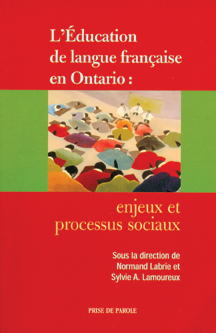 Learning,
Teaching and Living in French Ontario: Reality and Contradictions Learning,
Teaching and Living in French Ontario: Reality and Contradictions
by Gabrielle
Barkany
What problems do Ontario parents of children studying in French encounter
when they want to get involved in school life? Are professional learning
programs meeting the needs of francophone teachers? What is life like for
franco-Ontarian students and for other minorities within this minority?
These are some of the questions that researchers at the Centre de recherches
en éducation franco-ontarienne (CRÉFO) address in a recent
publication titled L'Éducation de langue française en Ontario
: enjeux et processus sociaux (French-Language Education in Ontario: Social
Issues and Processes).
The book addresses what it means to learn, teach and live in a Franco-Ontarian
school environment, reporting on various studies that have been carried
out since 1996.
Its nine essays could be loosely grouped under four themes: the exercise
of power within the education system, the handling of difference, professional
training (including pre-service and professional development) and students'
experiences. Articles also explore some of the contradictions and conflicts
that arise among government, school boards, schools, the public, parents,
education specialists and students.
In one chapter, "From the 'Steamer Classes' to Special Education: Creating
Difference," Nathalie Bélanger discusses one of the greatest
challenges facing the French-language schools and school boards: how to
provide support for special education teachers and students without stigmatizing
the students.
Bélanger's work is based on her ethnographical observations in French-language
elementary and secondary schools, where she discovers that there is no consensus
on ways of coping with difference.
She notes a range of power conflicts between teachers and parents when students
are identified as exceptional. In one example, a parent felt their child
was treated as an outsider and that the special attention and lowered expectations
were the source of social problems and that time out of the classroom for
special attention was putting her child even further behind.
In another chapter Bélanger teams up with Denise Wilson to continue
her analysis. "Pre-Service Teacher Education: Coping with Difference
or Valuing Similarities?" presents the findings of a study of nine
courses in two faculties of education, examining whether pre-service teacher
education programs and practices respond to the challenges of mainstreaming,
as defined in Ministry of Education guidelines.
One pre-service course had been designed to help prospective teachers identify
individual differences with a view to ensuring a classroom management strategy
conducive to learning. But notwithstanding this example, Wilson and Bélanger
note that most courses at the pre-service level focus on training teachers
to recognize students' problems, rather than how to integrate the students.
The authors predict that future teachers will be more likely to familiarize
themselves with bureaucratic and legal procedures (primarily on the basis
of cultural differences or the various exceptionalities that have been defined
by the ministry) than to develop a critical sensibility concerning current
approaches.
In "Professional Learning for Teachers," researcher Diane Gérin-Lajoie
notes that teachers must cope with a shortage of material and human resources
in French and are often isolated.
Some find that they are the only French teacher in their subject area in
an entire school board. They have no colleagues with whom to share experiences,
materials or resources. Gérin-Lajoie sets out the training needs
of teachers working in French-language schools, but concludes that academic
policies and programs rarely consider the needs of these teachers.
In "School Governance and the Creation of District School Boards,"
Normand Labrie, Denise Wilson and Monica Heller note that francophone communities
have governance of their schools, but boards are now more tightly controlled
by the provincial government - which gives community-elected officials little
latitude.
In a second essay, Labrie, Wilson and Heller are joined by Sylvie Roy to
write "School Councils: The Road to Increased Democracy?" This
chapter presents a critical analysis of the establishment of school councils
and district school boards. It shows that the restructuring of the school
system, which was supposed to give parents more power, has led to confusion
about the role of school councils versus the former parent-teacher associations.
The final chapters of this book touch on the experience of students and
issues of identity. One finds that a bilingual identity is not necessarily
consonant with assimilation. Another explores the issue of sexual orientation
and reveals that girls and boys have a different experiences of discrimination
as minorities within the francophone minority.
The studies carried out by researchers in L'Éducation de langue française
en Ontario : enjeux et processus sociaux have their roots in Ontario's francophone
environment, but they point to social phenomena and issues that exist beyond
both francophone and Ontario communities - in other francophone communities
in Canada and among linguistic minorities in other parts of the world.
L'Éducation de langue française en Ontario : enjeux et processus
sociaux, Éditions Prise de parole, $25
Resources
 Geometry
Park - CD Geometry
Park - CD
Produced by Joe
Crone and Illumisware
Reviewed by Andrea Murik
Do your students need motivation to learn grammar, Canadian geography
and fractions? With Geometry Park you can address Ontario curriculum
expectations while entertaining your students with a rhythmic collection
of upbeat tunes.
Although the title might lead you to expect only math concepts, Geometry
Park integrates science, geography and language curriculum from Grades
4 to 8. From "The Provinces Rap," to "Slip to the Side"
(on the rules of rounding), students will be singing the praises of this
fun-filled CD.
Geometry Park is catchy, contemporary, fun to listen to and has
easy-to-learn lyrics. Songwriter and teacher Joe Crone, who has taught
music and drama from Kindergarten to Grade 8, believes children learn
best through music. He has created simple rhymes and repetitive melodies
that stick in the mind - helping students remember various concepts, facts
and rules whether grammar, fractions or rounding-off.
As a former Grade 5 teacher, I especially enjoyed the songs about digestion
and circulation, "Digestion Blues" and "The Beat Goes On."
The CD also comes with karaoke versions of each song, so students can
perform themselves. Lesson plans and lyric sheets with chord charts are
available from the Illumisware web site, which makes it easy for teachers
to use this resource in the class and for concerts. This CD is a must-have
for Grades 4 to 8, especially for those of us who are not necessarily
musically inclined.
Geometry Park; London, ON; 2003; CD, $24.95; Illumisware; Fax:
519-455-1352; www.illumisware.com;
joecrone@hotmail.com
Andrea Murik is a Special Education Resource Teacher at the Simcoe
County District School Board.
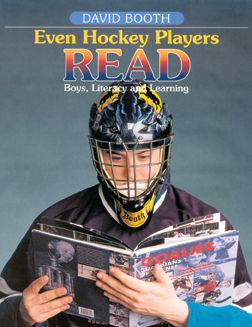 Even
Hockey Players Read: Boys, Literacy and Learning Even
Hockey Players Read: Boys, Literacy and Learning
By David Booth
Reviewed by Brenda Dillon
In his recent book, David Booth - noted speaker, author and professor
of education at OISE - argues that gender plays a complex role in reading
success and that this must be recognized if boys are to become successful
readers.
Even Hockey Players Read addresses the nature of literacy, explores
the social expectations for male and female readers and suggests strategies
and solutions for dealing with literacy concerns and problems.
Booth argues that the classroom environment typically provides better
literacy support for girls than for boys and advocates changes to support
the literacy development of boys.
He points to a misplaced emphasis on narrative fiction in language arts
programs, noting that boys tend to favour non-fiction. To make a difficult
situation worse, a focus on character development, relationships and readers'
emotional response to literature also tends to make things easier for
girls than for boys.
Excerpts from interviews with - and writings by - boys, men and children's
authors illustrate Booth's points and provide insight into how teachers
and parents can support boys' development as readers. Lists of recommended
books and readings are provided.
In Even Hockey Players Read, Booth addresses a matter of great
concern. The book provides a comprehensive overview of complex issues
and questions that have no easy answers. Still, at times Booth's explorations
seem to go in circles without coming to grips with the matter at hand.
So, although Even Hockey Players Read is a worthwhile read, better
editing might have made it a less frustrating one.
Even Hockey Players Read: Boys, Literacy and Learning. Markham
ON: Pembroke Publishers, 2002. ISBN: 1-55138-147-8; softcover, 135 pages,
$18.95; phone: 905-477-0650 or 1-800-997-9807; fax: 905-477-3691 or 1-800-339-5568;
www.pembrokepublishers.com;
mary@pembrokepublishers.com
Brenda Dillon is the Teacher-Librarian at Philip Pocock Catholic Secondary
School, Dufferin-Peel Catholic District School Board.
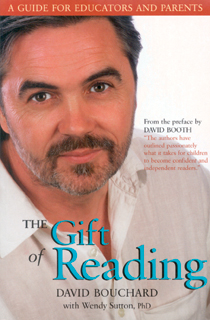 The
Gift of Reading The
Gift of Reading
By David Bouchard, with Wendy Sutton
Reviewed by Susan Elliott
Around the same time that I received a copy of David Bouchard's book for
review, I had the opportunity to hear him speak to teachers and administrators
at a small conference on literacy.
The message I heard at David's conference session resonates passionately
throughout The Gift of Reading.
Literacy is not for the fortunate few. It is the right of every child.
Teaching children to read is not the responsibility of a chosen few. It
is the responsibility of every teacher, every administrator and every
parent.
The Gift of Reading presents a very down-to-earth approach to the
effective teaching of reading. It specifically addresses families, books
and reading; teachers, students and literacy; administrators, districts
and schools, and includes suggested read-alouds and a bibliography.
Where the text diverges from the familiar is in the author's emphasis
on modelling in the teaching/learning process. He offers a convincing
argument that all adults who have contact with children must be seen as
readers if we are to foster lifelong learners who thrive on reading.
Bouchard does not shrink from meeting some controversial issues head-on.
His discussion of the impact of increased standardized testing on teachers
and students will be of particular interest. Furthermore, searching questions
threaded throughout challenge us to take action on both a personal and
professional basis.
In reflecting on The Gift of Reading, I found myself wondering
why, with all we know about reading, it remains so necessary to have our
attention drawn to such commonsense ideas? Yet, there are many lessons
to be learned and relearned. I believe this book should be on the reading
list of every parent, teacher, student teacher and administrator.
The Gift of Reading is thoughtful and entertaining and provokes
us to reflect anew on Mark Twain's wry comment, "Those who can read
and don't have no advantage over those who cannot."
The Gift of Reading; Victoria, 2001; ISBN 1-55143-214-5; softcover,
158 pages, $19.95; Orca Book Publishers; 1-800-210-5277, orca@pinc.com
A former principal in Ontario, Susan Elliott-Johns now lives in Prince
Edward Island, where she works as a teacher educator and literacy consultant.
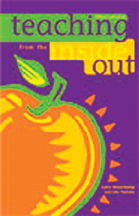 Teaching
from the Inside Out Teaching
from the Inside Out
By Larry Beauchamp and Jim Parsons
Reviewed by Caroline Cremer
Teaching from the Inside Out is a book for all beginner teachers
and for anyone who is thinking about becoming one. The authors clearly intend
to help new teachers know what teaching is really about. Various realistic
scenarios are presented and suggestions are offered on how to use professional
judgment to solve problems.
Divided into three sections, the book begins with straightforward questions
about reasons for wanting to become a teacher. Section two shares some of
the tricks of the trade and details such topics as lesson planning, maintaining
discipline, building inclusive classrooms, asking thought-provoking questions
and delivering effective instruction as well as testing and evaluating students.
The final section explores the realities of classroom teaching: what really
happens, the challenges and the rewards. Although nothing can fully prepare
you for your first year of teaching, this book gives some insight that will
serve beginning teachers well.
Beauchamp and Parsons present a realistic view of teaching that encourages
those who are meant to teach and may discourage those who go into teaching
for the wrong reasons. They bring to their book a wealth of experience,
knowledge and passion for the teaching profession.
Teaching from the Inside Out is a celebration of teaching and a reflection
of both Beauchamp and Parsons' dedication to restoring the pride in teaching.
Teaching from the Inside Out; Edmonton, 2000; ISBN 1-55220-106-6; Softcover,
216 pages, $24.95; Duval House Publishing/Les Éditions Duval; tel
780-488-1390 or 1-800-267-6187; fax 780-482-7213; duvalhouse@duvalhouse.com.
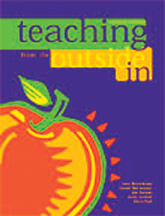 Teaching
from the Outside In Teaching
from the Outside In
By Larry Beauchamp, Gerald McConaghy, Jim Parsons, Kathy Sanford and
Dawn Ford.
Reviewed by Caroline Cremer
Teaching from the Outside In, the companion to Teaching from the
Inside Out, addresses the same responsibilities of teaching that were
highlighted in the first book. However, Teaching from the Outside In
takes a more hands-on approach and offers various suggested activities to
help discover the method most suitable for you.
In each chapter the authors ask thought-provoking questions on your teaching
practice to assist you in figuring out why some things worked and others
failed.
The nature of teaching demands that you perform, with or without theoretical
knowledge or in-depth experience. Beginning teachers seldom have time to
read theory and they have little experience to assist them in making the
professional decisions that are required. Clearly, the authors remember
what this was like and their book focuses on helping new teachers get through
their practicums and their first year.
The book is based on the suggestions and experiences of teachers and advice
stems from the authors' own mistakes. Theory has not been overlooked in
this book, but it is not the focus. Teaching from the Outside In
will help any prospective or beginning teacher and should be on the reading
list of all teacher candidate programs.
Teaching from the Inside Out; Edmonton, 2000; ISBN 1-55220-2003;
Softcover, 120 pages, $24.95; Duval House Publishing/Les Éditions
Duval; tel 780-488-1390 or 1-800-267-6187; fax 780-482-7213; duvalhouse@duvalhouse.com.
Caroline Cremer teaches Grades 1 and 2 at Leslieville Junior Public School
in Toronto.
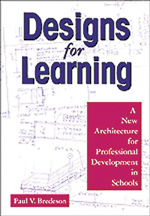 Designs
for learning: a new architecture for professional development in schools Designs
for learning: a new architecture for professional development in schools
By Paul V. Bredeson
Reviewed by Ruth Dempsey
In his 2003 release, Designs for Learning, Paul Bredeson defines
professional development as "learning opportunities that engage
educators' creative and reflective capacities in ways that strengthen
their practice." Hurrah!
Using the metaphor of architecture, the author applies the principles
of function, structure and beauty to professional development policies
and processes and offers a stimulating perspective based on six design
themes:
- professional development
is about learning
- professional development
is about work
- professional development
is a journey, not a credential
- opportunities for
professional development are unbounded
- student learning,
professional development and organizational mission are intimately related
- professional development
is about people, not programs.
Writing in an easy
conversational tone, the author explores the above themes in 10 insightful
chapters. These include: new designs for professional learning in schools,
creating learning spaces for professional development and evaluating and
implementing new designs for professional learning.
Building on the work of Parker Palmer's The Courage to Teach, Bredeson's
book charts the landscape of professional development bringing together
the intellectual, emotional and spiritual. "Reduce teaching to intellect
and it becomes a cold abstraction; reduce it to emotions and it becomes
narcissistic; reduce it to the spiritual and it loses its anchor to the
world. Intellect, emotion, and spirit depend on each another for wholeness."
Intellectually evocative and practically grounded, this book acknowledges
teachers as individuals and lifelong learners vitally engaged in their
world and their profession. It should be at the top of the reading list
for teachers, principals and anyone involved in planning, implementing
or evaluating professional learning in and beyond schools.
Designs for Learning: A New Architecture for Professional Development
in Schools; Thousand Oaks, CA 2003; ISBN 0-7619-7889-5; softcover,
176 pages, US$29.95; Corwin Press; tel 1-800-818-7243, fax 1-800-417-2466;
www.corwinpress.com
Ruth Dempsey is a member of the Ontario College of Teachers and an
instructor at the Faculty of Education, University of Ottawa.
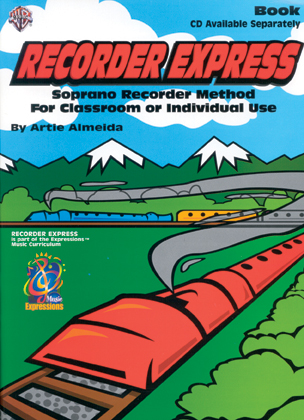 Recorder
Express: soprano recorder method for classroom or individual use Recorder
Express: soprano recorder method for classroom or individual use
By Artie Almeida
Recorder Express: CD with 99 tracks
Reviewed by Mary Hookey
This new book provides a traditional approach to beginning recorder instruction.
Students start with the left-hand fingerings of B, A, G, C, & D -
reading directly from the five-line staff.
There are many songs and exercises in the first 19 pages that should build
confidence in playing these first five notes.
The songs and exercises in the remainder of the 48-page book cover an
octave and a half of the C scale plus F#. Theory sections are clear and
short and the book includes a fingering chart and many well-known folk
songs.
The Recorder Express CD, sold separately, includes accompaniments
in a variety of musical styles that should keep students motivated and
challenged - requiring them to play at the recorded tempo.
A professional recorder player provides a model for students on 14 of
the tracks. Beginners will benefit from these examples of proper breathing,
tone and technique that support the teacher's demonstration.
Recorder Express; Miami, 2003; ISBN 54979-05094; softcover, 48
pages, US$4.50 - book, US$12.95 - CD; Warner Bros. Publications, 305-620-1500;
Fax 305-621-4869
Mary Hookey has been a music teacher and music teacher educator. She
is now retired.
|

 Learning,
Teaching and Living in French Ontario: Reality and Contradictions
Learning,
Teaching and Living in French Ontario: Reality and Contradictions Geometry
Park - CD
Geometry
Park - CD  Even
Hockey Players Read: Boys, Literacy and Learning
Even
Hockey Players Read: Boys, Literacy and Learning The
Gift of Reading
The
Gift of Reading Teaching
from the Inside Out
Teaching
from the Inside Out Teaching
from the Outside In
Teaching
from the Outside In Designs
for learning: a new architecture for professional development in schools
Designs
for learning: a new architecture for professional development in schools Recorder
Express: soprano recorder method for classroom or individual use
Recorder
Express: soprano recorder method for classroom or individual use